Archives, films and memories: ingredients to remember and forget the past
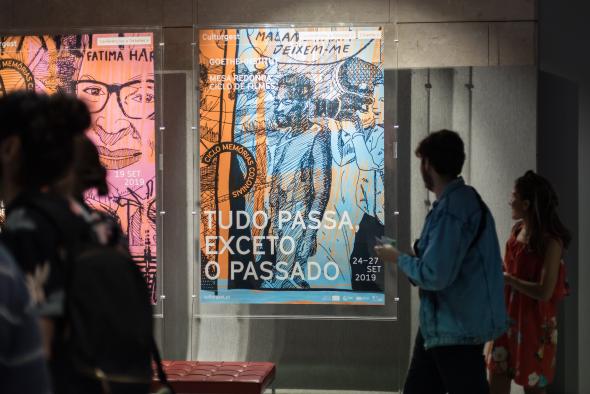
To begin with the story of a boy who either lived in the present, or was consumed with recalling the past, is to remember part of a short story by the Argentinian writer Jorge Luís Borges about the young Irineu Funes, a fictitious character. An accident caused Funes to forget nothing, and to remember every detail of the past, thus making him suffer from an inability to differentiate or elaborate on his memories. Remembering everything made him incapable of thinking about the past. Funes’ condition contrasts with [Everything passes except the past], an international workshop about the politics of memory, promoted by the Goethe-Institut, which took place over a few days of September at Culturgest in Lisbon, in tandem with the cinema programme, Re imagining the post-colonial archive. Unlike Funes’ condition this event was about reflecting on the relationship between remembering and forgetting the past.
With the aim of enabling a wider debate on the past through dialogues between films and people from various parts of the world, the workshop brought together a number of cultural producers, archivists, researchers and artists, dedicated to creating, preserving and spreading partial and incomplete memories. The result could not have differed more from Funes’ meticulous memory, so precise that it neither discarded nor compared anything. Alternating between public and internal sessions, debates focused on how to work in, with and on film archives, drawing a map with multiple points of view on the mutability of memories.
The wide range of participants, in their diversity of practices and origins, stimulated confrontations between ways of working on memory through archives. By bringing together speakers from Angola, Belgium, Egypt, England, Germany, Ghana, Guinea-Bissau, the Netherlands, Mozambique, Nigeria, Portugal, and the Democratic Republic of Congo, the origin and work of the participants established unique relationships with the archives with which each one at the workshop had become involved, and various types of film archives. The space for dialogue between participants who work about forgetting and memory from various positions and resources made the workshop captivating. Each participant brought his or her own story and balance between thinking about the past, living the present, and dreaming about the future of memory. They showed how they are different and what they have in common, how much each knew or was unaware of each-others’stories, and how much they have to offer each other. For example, one participant shared the story of Funes.
The film material safeguarded in the archives are stimulating resources with which to work on the construction of memory. Simultaneously inheritance and testimony, they can become valuable tools for working on the politics of memory, of what we remember and forget about the past, and the instrumental role of archives in these processes. An archive lives when it is used, but it is only valid when the material it holds reaches the public space. This idea is grounded in a desire to encourage public access to archives, an access that frees the past from the dominion of memories built by those who have either political, economic, or social power. This liberation allows one to use the archives to think about memory and history in their different dimensions and overlaps, disparate or complementary - collective, personal, institutional, subordinate, intimate, public memories.
Diversity was also one of the keywords used to define the world of film archives. National public archives functioned as references in many of the debates, but the cases presented included archives with large or small collections, specialised or wide-reaching, institutional or informal, public or private, newly-built or long-standing, decaying or dynamic, collaborative or selective.
With the advantage of establishing a dialogue between people in different positions in history, the plurality of perspectives drew a complex cross-section on the issue of memory built on the nation-state, and its ambiguous relationship with film archives. Fighting different official narratives and national imaginaries instituted in equally plural and unequal societies, the participants have pursued their work between dominant and forgotten memories. From discussions on this minority work by an extensive range of people trying to invert current policies of forgetting and memory, emerged a call for civil society to play a greater role. This role might allow to establish a new basis for the future, one that differs from the existing dynamics.
The partiality of existing records, as well as the particular focus chosen on them, offers the possibility of thinking in the present, not only about the occurrences of the past, but also about the diverse meanings added by the passage of time. In a world that experienced structural political changes in the last century, it is challenging to think about the mutability of memory through material produced for documentary purposes. While an accident may have given Funes the ability to retain the entire past, no archive can achieve that nature. The urgency of constructing archives results from the need to place multiple versions of history in the public space, and to preserve a broader range of memories than those currently subjugated by dominant narratives. In the stories of each of the participants, we find motives and ways for recovering the past, and contemporary meanings of constructing memories.
Tearing down borders: emergency archivists
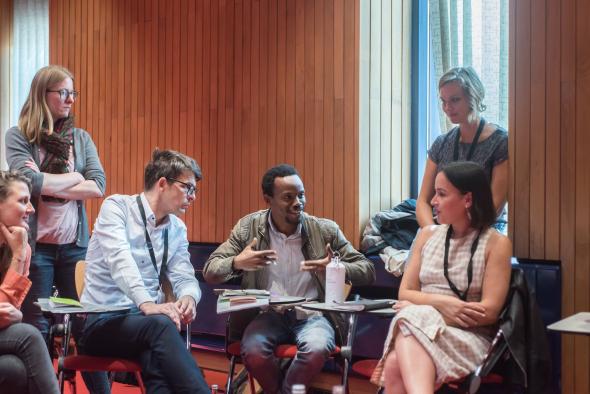
Let us begin with the peculiar story of an independent Nigerian filmmaker. Nigeria is the African country with the biggest commercial film industry, usually called Nollywood, for its equivalence to Hollywood. While visiting an abandoned building, the filmmaker accidentally came across some deteriorated reels, containing remains of films produced in the 1940s and 1950s by the colonial cinema unit established by the British government. Because he sensed the partial nature of the memories in his hands, over the years, the filmmaker gradually became an archivist. An accidental archivist trying to restore a collection whose rough history led him to ask himself how nation states support policies of both remembrance and of forgetting, an archivist who investigates how successive governments activate or deactivate archives, depending on whether these resources appear to convey a history they want to maintain. Deteriorated records cease to talk so much about the past they refer to, as they scream about the policy of forgetting that has ruined them.
Or the story of an Egyptian filmmaker who became an emergency counter-archivist. The doors to his country’s national archive are closed, limiting access to the fragments of memories it holds. By refusing its citizens the opportunity to discover them, it hampers the subsequent work of decoding these fragments of the past, and using them to think about the country’s history. Or the story of an Angolan filmmaker who spent 6 years producing film footage to build an archive of oral memories about a past that his country’s official history omitted from him.
These are stories of archivists who did not become so by training, but because, at some moment in their lives, they were faced with the need to set up archives with memories that were forgotten, deteriorated, closed or suppressed; all of them side-lined. These stories overlap while, at the same time, become unique, revealing turbulent relationships with the domains of national memories. They are stories of people trying to amplify the dominant public memory, to break the supremacy of access and control by any government or national structure - who struggle so that Funes’ inability to think does not dominate their memories. Induced by official politics of memories, they show ways to resist forgetting, fought through the creation of new material and new uses for the old, of fragments of memories that have hitherto been side-lined.
Besides being new archivists, these filmmakers have in common the fact they grew up in countries which became independent relatively recently, countries and archivist-filmmakers sharing the same age. So that there may be no misconceptions - other participants at the workshop embark on a similar struggle, dealing with memories of older countries concerning pasts of colonial domination.
Archives are structured repositories, whose dynamics depend on their archivist, a considerably more transitory element in comparison to the potential permanence of institutions or collections. The story of a German archivist who sees the users of the archive where she works as potential archivists is useful here. This archivist values what each user has to say about the fragments of memories of the world that she guards. This archivist regards archives as guardians of fragments, by definition incomplete, seeing in the interactions of the present the possibility of adding valuable aspects to them: whether of knowledge, new production, or new reflections. In a context dominated by film archives that store national cinematographies, as this one is supplied by a world-wide independent, militant, or resistance film festival, is it by chance that the archive where she works has such a unique collection?
In the discourse of these guardians, researchers, or producers, addressing historical moments through different relationships in the production and use of documentary film records, there was a notable convergence: their intention to challenge current perceptions about the past. Insofar as parameters taken for granted in a certain context are called into question in another, this common objective made the gathering productive, bringing up the question of the politics of memory and various relationships with the construction of history. Archives also store the cracks of dominant memory, and can generate controversy, be it about access or control of material, or about dominant public narratives established in the past.
The bewilderment of fragments of the world’s memory
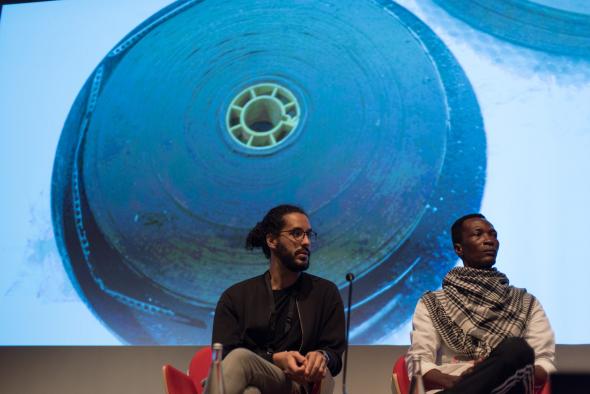
The travel required to gather these people in the same place begs the questions of territoriality underlying material produced in different parts of the world, but today stored in the archives of former metropolises. The impact of the inherent contradictions of these political changes, in a sphere largely subordinated to immutability, brings up questions on the identification of these materials and its ease of access.
What can be done to establish a path between material filmed in one territory, and stored in another, usually the former European power? These legacies of the past are currently unknown in both the now-independent countries, and those with pasts of colonial control. The ways of knowing them remain subjugated to the historical categories called into question by fairly recent political changes. As shared histories lived from opposing perspectives, until recently some dominant and others subordinated, the latter struggle for a place from which they can question their opponent.
An Angolan director was intrigued by how he could find only a few images of guerrillas from the fight for independence in Portuguese archives, until he realised that a search for “terrorists” gave him a much wider panorama of the kinds of images he was searching for to access his history. Archives are simultaneously places that retain materials produced in the past, and systems with pre-established ways of organising them. If memory emerges as a contested territory, archives emerge as repositories where the forgetting of successive generations can be shaken by tools created and used in the past. It makes archives themselves contested territories, not only because of the contents they contain, but because of the structures used for indexing, or their access policies - tools with which resistance and revolt are now produced. Archives are good for thinking about the construction of the world’s memory, they are stimulating because of their unique partiality.
If there are multiple versions of history, depending on who writes it and who reads it, is it possible to connect all the archive databases together, in other words, how can institutions with different levels of formality communicate and collaborate with each other? How can we redistribute the disparate material held by European archives on non-European territories that are now independent nations? In what framework could this redistribution be done? Who could be involved?
Accessing film material archived at a transnational level is not easy; nor is reusing it. The majority of archives charge prohibitive amounts to low-budget independent productions (whether due to regulations on copyright, production, or costs of the process of facilitation); only a minority offer the use of images in their custody.
We now come to the matter of access, the recurring feeling induced by many archives throughout the world, of a closed door, sometimes slightly ajar, but rarely open. The frequent adoption of restricted-access policies has come to create relatively restricted layers of privilege – researchers, filmmakers, and, increasingly, artists. For these researchers, filmmakers and artists, the privilege of access is accompanied by the responsibility of interrogating intentions – whether of these fragments, of the events that created them, or of the condition of archived fragments; by the responsibility of placing in the public domain the discussion of fragments of the now-forgotten past, shelved in narratives constructed in other times, through specific perspectives.
To overcome the closed-door sensation of film archives, we need to debunk the idea that preserving the material they safeguard consists exclusively of maintaining its materiality intact for the future. The matter has been called into question by the increasing rediscovery of material in various states of preservation. What future is there in this limited access in the present? Closed off, who does that memory serve, and for what? From the growing number of films that interrogate archival material, tracing back memories hitherto incarcerated in archives or by dominant narratives, we know that an open door allows us to think today about the changing meanings that fragments of the past may suggest to us – to current viewers, a future materialised as archivists of that past.
Perhaps the ideal future for archives is to replace the feeling of a closed door with that of a revolving door that strengthens mutual collaboration, that makes their images and their past histories circulate, and brings them alive for the present.
Resist forgetting the others: mediation and collaboration with images from the past
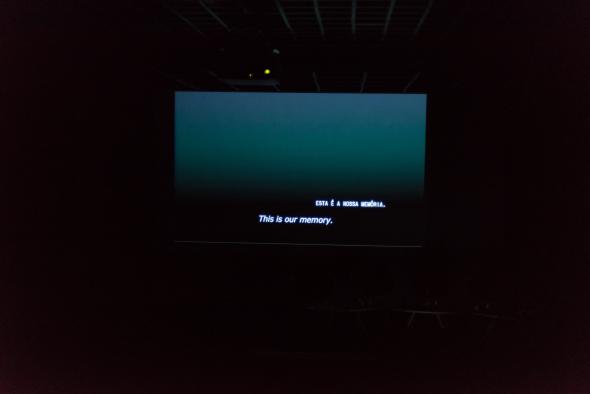
Below are stories about activities with fragments of the past, which aim to disturb existing supremacies. Stories about ways of overcoming some of the difficulties of establishing other constructions of memory, thereby controlling their story a little. Inequalities in infrastructures, both in terms of preservation and access policies and politics of memory, have not prevented work being done - they have made it difficult, but their emergence is unshakable. What remains pending is the visibility of the resulting work, which makes telling their stories even more important.
A Congolese cultural producer is collaborating with European museums and archives to get artists and cultural producers in his country to work on images produced in colonial times. Through artistic practices he makes young people today deal with these images of the past. The producer started the project using remote access, but technological mediation hindered fluid interactions between historically connected strangers. The producer overcame this obstacle by visiting one of the Belgian archives in person, where he confronted the emotional difficulty of overcoming the inequality he saw etched in these photographs and films. While showing these images to his family on his return, he was shown ways to heal those emotions, and the importance of working with these images of the past today – of using them to add dynamics from the present.
His story resonates with that of a Belgian artist who carries out her work in German museums on photographs depicting people from all over the world, images reconfigured in systems of abstract categorization established several decades ago. As, most of the time, they imply the dehumanization of the subjects portrayed, these images are rarely used today and little known, preventing discussions about their existence and their preservation. How can another future be imagined without discussing this past or marking it with a present?
Like the work of archivists and artists, that of researchers mediates between films of the past and the present, a present marked by decades of independence of the territories where the film records were being produced. Let us point to the story of an English researcher who has studied British colonial films produced in various parts of the world, and today held in British archives. His research aims to facilitate access to these films together with critical interpretations of their production through a contemporary approach to these weighty colonial productions. Or that of a Portuguese researcher simultaneously researching stories of films produced in colonial times and their counterpoint, films of militancy and resistance to Portuguese colonialism. These films produced in territories that have suffered lengthy colonization, establish gestures of domination and resistance through the same tool, the cinema.
Let us also emphasize the role of collaboration. For example, the collaboration between a Portuguese artist and a Guinean director, who seek, through forgotten militant films, to recover the living memories of their production. Mistreated by neglect since they were produced, their physical restoration was possible through the aforementioned German archive, which has an unapologetically transnational collection. It is also the transnationality of these collaborations that seems to determine the possibility of establishing dialogues with these legacies today. How different is the case of a Portuguese director of German Jewish origin who works on the border between personal and collective memory - and who looks at his personal history to question a social history?
In a workshop with people from different backgrounds, the question of the participants’ various languages and the inevitable decision on a lingua franca is raised. Any choice implies aspects that may or may not eventually become problematic. In the non-public events there was simultaneous translation from English to French so that some of the participants could follow and participate in the discussion. Simultaneous translation made the participants’ linguistic diversity audible. The audience at public events added further difficulties to navigating the diversity of languages, contexts and experiences of those involved. In order to deal with this tower of Babel, the strategy at events open to the public consisted either of simultaneous or consecutive translation. The enthusiasm generated by the possibilities of a meeting dedicated to sharing between people from different countries with diverse experiences, created expectations that were difficult to meet in a context in which hardly anyone was listening to their mother tongue. Learning about the memories and experiences of others requires a work of patience that not everyone is always willing to undertake.
In the internal sessions, the programme aimed to include screenings, which quickly created time constraints for the debate. The organisation’s response consisted of quickly rethinking a schedule that had taken months to develop, with the purpose to make more time available for dialogue about each other’s experiences and for group discussion.
The documentary films or excerpts shown during the workshop, in public or internal sessions, also formed a wide spectrum, both in terms of context and production location, including films produced in the distant past, and others produced more recently and constructed through fragments of the past. Digitalized analogue films were seen, some restored and others in the physical condition they were found, and recent films that use archival materials in the most diverse conditions. The films and excerpts previously chosen by some of the participants set the tone for debate; let us briefly consider their reception.
It’s not the form, it’s the text
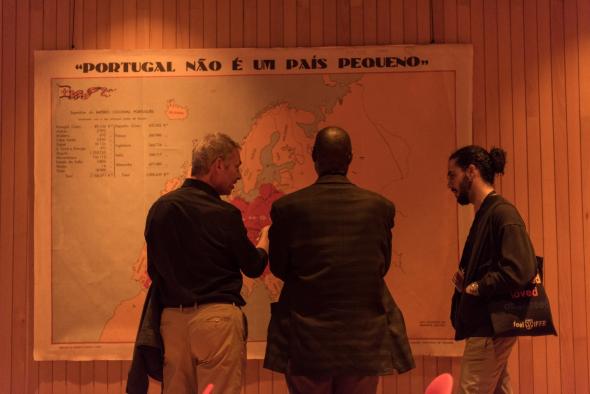
I will not be impartial in my choice, selecting films with a similar formal device (dispositif), which provoked different reactions in the viewers. On three or four occasions, the participants saw excerpts and films in their entirety that suggest that what affected the viewers’ reaction to these images with a documentary appearance, was not so much a question of form, as a question of text. To highlight the different reactions to formally similar films, shaped, however, by different discursive approaches, I will consider them in a different order from the one in which they were shown. I am interested in going through an opening movement of the narration, a change of the narrator’s posture and his text.
Let us take as a reference an audio-visual device with an explanatory narration, constructed on the basis of the distance between those who film and those who are filmed, characteristic of many films produced in colonial contexts for propaganda purposes. This form also epitomises the style of television journalism reporting, and of the educational documentary, both in contrast to the authored documentary. If today the former genre is associated with propaganda purposes, the latter genre continues to value authority and veracity - but not as documentary cinema. For this there is the third genre, of authored documentaries.
So as not to forget the deafness of colonial cinema’s discourse towards the subjects it filmed, one of the participants, chose to show a short colonial film produced in Cameroon in the 1940s whose sound had deteriorated to the point of being difficult to understand, accompanied it with a transcript of the narration. This gesture highlights the weight of the textual aspect in the perception of images - it makes the narration an indicator of the kind of authority that a film seeks to have.
Thus, we start by talking about an excerpt from The New Egyptians (1977, by Michael Croucher, England), a documentary produced by the British television channel BBC, about the daily life of a family living in Cairo. The British speaker explained what the image does not explicitly convey to a viewer unfamiliar with the context. Sarah Maldoror’s documentary, Fogo - Île de Feu ([Island of Fire], 1979, 23 min. Cape Verde), produced through a commission from the PAIGC, a liberation movement that became the political party in power in Cape Verde and Guinea Bissau, formally followed the same tone. Its assertive discourse about the inhabitants portrayed was a carbon copy of the same strategic expedient, where the voice of those filmed appears obliterated. In the audience, the question asked applies to any of these films: how much of their text has been produced in collaboration?
There was a more ambivalent reaction to Daniel Blaufuks’ film, Judenrein (2019, 11 min.), which sought in his narration to offer a reflection on social dimensions that the images alone did not show - the change in the sociological parameters of the population of a Polish village, from a Jewish majority to a small minority, after the closure of the Nazi concentration camps. Found for sale in the virtual world, the images that the narrator considered have no known author. The off-screen speech results from a negotiation between history and image, a conscious choice to highlight a story hidden in the images, through questions to the images. The choice was made to build a personal discourse on the visual and material aspects, mediated by their relationship with these images and the media holding them. After the screening, a healthy discussion was generated concerning the value of a personal text, as a counterpoint to the usual detached nature of texts in colonial films. We had the opportunity to see a similar narrative device in Préface à des Fusils pour Banta ([Preface to Arms for Banta], 2011, 26 min. by Mathieu Kleyebe Abbonnenc), a short film combining the use of archival photographs with animation. The text, narrated by a female voice, included the outline of a project by Sarah Maldoror, which did not find its final form as a film. When completing an unfinished project 30 years later, the text of Abbonnenc’s film plays with an imagined past of what it could have been.
The public screening of a silent film, which consisted of a documentary record of the first national assembly of Guinea-Bissau, in 1973, was widely applauded. The film was presented with the living testimony of Sana na N’Hada, its director, who was present in the room, in a recollection translated into English by the artist Filipa César, with whom he has collaborated. The audience participated in a real-time negotiation between the moving images, memory, and its translation, in a session that showed how Guinean cinema was born at the same time as the country.
Other films that used the device of narration, combined interviews or speeches by their participants - as in the case of Uma Memória em Três Actos (2016, 64 min. by Inadelso Cossa, Mozambique); as well as Carnaval en Guiné Bissau (1980, 13 min. by Sarah Maldoror, Guinea Bissau). Even bearing in mind that these voices are always mediated, between the current discourse of political propaganda and the hitherto silenced discourse of their experience of the past, those who were given a direct voice varied. Thus, the same device appeared with different connotations.
Reactions after the viewing were followed by conversations inquiring into how the film just seen was produced, and its respective circulation or use. In most cases, these aspects are absent from the film itself, but could be obtained from the multiplicity of devices supporting its screenings: in its programme, in its presentation, or in its discussion. Conscious of the ephemeral nature of their work, the specialists worked even harder.
Opening memory to the world and connecting the worlds of memories
By bringing together the voices and experiences of filmmakers, artists, archivists and cultural producers, the workshop was instigating. Aiming to discuss the legacy of film archives, the debate not only revealed the intensity of the question of memory, but also the vitality of work on fragments of the past that is being produced in various parts of the world. It opened the door to new dialogues between different practitioners as well as between agents familiar with opposing historical narratives. It established the possibility of building networks and connections between knowledge, practices, interests, ideas, experiences, and outlooks. The audience that attended the cinema sessions, discovered events where film archives were used as places that can make us question what we learn through our eyes - through both films and their discussion - why and how were they made, where were they shown? - in order to think about the past and the memories we have of it today.
The workshop enriched a debate that has been developing in Portugal about film archives, different fragments of the past, structures for their preservation and identification, and their uses. We are far from having the capability of Funes’ unfailing memory. The workshop showed that this is not the capability we are missing. What we lack is more spaces for us to listen and think together about issues of memories.
Image credits: Bruno Castro/Goethe-Institut.